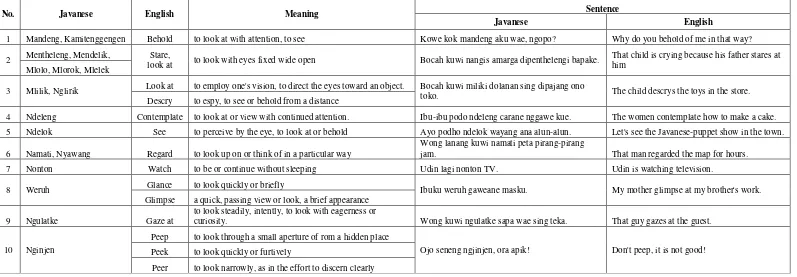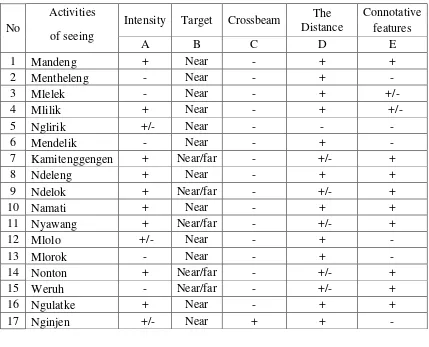REGISTER, VOL. 2, No. 1, JUNE 2009 element of context that may influence the word choice in both languages. By using documentation as method of data collection, it is found that there are many different words having the same meaning to say ‘melihat’ in both languages while those words means that anyone doing activities of ‘melihat’. In addition, the aspects of intensity, target, distance, and connotative features influence the word choice in either Javanese or English.
Keywords:Componential Meaning, Melihat, Javanese, English
Abstrak
Ini adalah penelitian deskriptif kualitatif yang berusaha untuk
menggambarkan makna komponen pada kata „melihat‟ dalam bahasa Jawa
dan bahasa Inggris serta meneliti elemen konteks yang mempengaruhi diksi pada kedua bahasa tersebut. dengan menggunakan dokumentasi sebagai metode pengumpulan data, penelitian membuktikan bahwa ada banyak kata yang berbeda yang memiliki kesamaan makna untuk mengungkapkan kata
„melihat‟ pada kedua bahasa. Sedangkan, kata-kata tersebut memiliki arti
bahwa pelaku melakukan aktifitas „melihat‟. Di samping itu, aspek intensitas,
target, jarak, dan ciri-ciri konotatif mempengaruhi diksi pada bahasa Jawa maupun bahasa Inggris.
REGISTER, VOL. 2, No. 1, JUNE 2009 2
Introduction
Every language has different system that characterizes its use, likewise
Javanese and English. To say „melihat’, for instance, there are many words
3. Rina ngamati gaweane koncone sing lagi digarap.
Those three words have different forms but similar meaning; expressing
„melihat’. In English, the same thing can be found, for example: 1. My brother is watching TV.
2. Look at the street!
3. The teacher observes the student assignments.
From the above examples, different words which have the same meaning
in the sentences called synonymy. The words „begin‟, „start‟, „sofa‟, „settee‟, „adore‟, and „worship‟ are just a few of hundreds words that seem to be
frequently interchangeable without loss of meaning. However, they are truly synonymous that they always mean the same and can be substituted one another (Carthy, 1990: 16). Therefore, we need to know the meaning of the word deeply before using it. Sometimes we are confused to understand words we do not know the meanings exactly. Not only in English, in Javanese have we also found the synonymy that shows the richness of word meaning.
Derived from that phenomenon, the writer is interested in conducting the analysis of componential meaning of the word between two languages by addressing following research questions.
REGISTER, VOL. 2, No. 1, JUNE 2009 3 2. What are the components of meaning that differentiate between one word
to another in English synonym of the word ‘to see?
3. What element of context that may influence the word choice in Javanese and in English?
Semantics
Semantics is the technical term used to refer to the study of meaning. It is a part of linguistics that not only includes meaning but also development and changing (Palmer, 1981: 1). According to Fromkin (1985: 201), it is a study of linguistic meaning of words, phrase, and sentences.
Lexical Relation
In the discussion of meaning, there are many parts to be elaborated; one of them is lexical relation. According to Saeed (1997: 36), there are eight lexical fields in the lexical relation.
1. Synonyms, which are different phonological words which have the same or very similar meaning.
2. Antonym (opposition), words which are opposite in meaning. 3. Homonymy, unrelated senses of the same phonological words. 4. Polysemy
5. Hyponym
6. Meronymy
7. Member collection 8. Portion-mas
Componential Analysis
REGISTER, VOL. 2, No. 1, JUNE 2009 4 and labels for concepts that speakers wish to discuss. Then, how does the meaning of words in a sentence contribute to the meaning of sentence? Componential analysis of this kind can reveal a relation among words from the same semantic domain, such as kinship terms. It attempts to describe the systematic ways in which words are alike or unlike ( Carthy, 1990: 92). He (1990: 92) states that it is also the way of looking at the meaning of words, describing words in terms of shared and non-shared semantic features, these features themselves being only expressible as words.
Semantic componential analysis is based on the similarities among set of words. The goal of semantic feature (componential) analysis is to discover a set of features that make up the meanings of words. In this analysis, the lexical relation of synonym is important because words related to the ways of sharing features. The purpose of semantic field analysis is to arrive at meaning shared by a group of words in a domain. That, all the words within the field related to each other, yet differs in details, which are captured in the analysis.
The componential analysis can be applied satisfactorily only in certain well-defined semantic domains. In many cases, it is difficult to define the
elementary “features” which distinguish the meaning of a word from that of
similar ones. For instance, the word „chair‟ has some similar meaning with bench, davenport, and sofa. But, it is not exactly the same; there are some features differentiate them. It is described as follows.
Wood substance Foot Expensive Hand
REGISTER, VOL. 2, No. 1, JUNE 2009 5
Sofa ± + + +
From the table, the distinctive features of those words are the substance, shape, and the price of the chairs.
Research Methodology
It is a descriptive qualitative research that is used to depict the phenomenon of the using of the word ‘melihat’, as object of the study, in Javanese and English. Since it is a literary study, the writer uses documentation as data collection method that is taken from primary and secondary books i.e.:
1. Introduction to Theoretical Linguistics (1997) 2. Introducing English Semantics (1978)
3. Semantics (1981)
4. Kamus Bahasa Jawa (2002) 5. Bausastra Jawa-Indonesia (1957)
6. The New Grolier Webster International Dictionary of the English Language (1974)
7. An Introduction to Psycholinguistics (1992) 8. Semantik Leksikal (2001)
Discussion
REGISTER, VOL. 2, No. 1, JUNE 2009 6 Those data, then, are analyzed descriptively using the semantic field of the word ‘melihat’ or ‘to see’. They are:
1. Intensity
It shows duration of seeing. 2. Target
It means any object used for the purpose of seeing. 3. Crossbeam
Crossbeam refers to something that delays activity of seeing. 4. Distance
Distance shows an interval or space between two objects. It means the distance between the doer and the target of seeing.
5. Connotative
It means implication of a word or phrase in addition to its literal meaning.
REGISTER, VOL. 2, No. 1, JUNE 2009
7
Table 1.1. Data Presentation
No. Javanese English Meaning Sentence
Javanese English
1 Mandeng, Kamitenggengen Behold to look at with attention, to see Kowe kok mandeng aku wae, ngopo? Why do you behold of me in that way?
2 Mentheleng, Mendelik, Stare,
look at to look with eyes fixed wide open Bocah kuwi nangis amarga dipenthelengi bapake.
That child is crying because his father stares at him
Mlolo, Mlorok, Mlelek
3 Mlilik, Nglirik Look at to employ one's vision, to direct the eyes toward an object. Bocah kuwi miliki dolanan sing dipajang ono
toko. The child descrys the toys in the store.
Descry to espy, to see or behold from a distance
4 Ndeleng Contemplate to look at or view with continued attention. Ibu-ibu podo ndeleng carane nggawe kue. The women contemplate how to make a cake.
5 Ndelok See to perceive by the eye, to look at or behold Ayo podho ndelok wayang ana alun-alun. Let's see the Javanese-puppet show in the town.
6 Namati, Nyawang Regard to look up on or think of in a particular way
Wong lanang kuwi namati peta pirang-pirang
jam. That man regarded the map for hours.
7 Nonton Watch to be or continue without sleeping Udin lagi nonton TV. Udin is watching television.
8 Weruh Glance to look quickly or briefly Ibuku weruh gaweane masku. My mother glimpse at my brother's work.
Glimpse a quick, passing view or look, a brief appearance
9 Ngulatke Gaze at
to look steadily, intently, to look with eagerness or
curiosity. Wong kuwi ngulatke sapa wae sing teka. That guy gazes at the guest.
10 Nginjen
Peep to look through a small aperture of rom a hidden place
Ojo seneng ngjinjen, ora apik! Don't peep, it is not good!
Peek to look quickly or furtively
REGISTER, VOL. 2, No. 1, JUNE 2009 8
Table 1.2. Componential analysis of meaning of Javanese words
No
Activities
Intensity Target Crossbeam The
Distance
Table 1.3. Componential analysis of meaning of English Words
No
Activities
Intensity Target Crossbeam The Distance Connotative
REGISTER, VOL. 2, No. 1, JUNE 2009 9
9 Peek - Near/far + + +/-
10 Peep - Near + + -
11 Peer - Near + + -
12 Regard + Near - - +
13 See + Near - - +
14 Stare - Near - - +
15 Watch + Near/far - - +
Ambivalence
In the table, it is seen that there are words have two signs i.e. (+) and (-) called ambivalence. It means that there are two meanings or purposes from the words depending on the context. Furthermore, such words are elaborated below, based on the componential analysis of meaning.
1. Intensity
In Javanese, ‘nglirik’ and ‘nginjen’ have two signs of positive and negative. ‘Nglirik’ can be high if the doer wants to make long seeing activities. However, it is also can be low if the doer makes it short or just a moment.‘Nginjen’ also has the same thing; the doer can make it either long or short. All of activities depend on the doer. In English, ther is no ambivalence of the intensity.
2. Target
In Javanese, ‘kamitenggengen’, ‘ndelok’, ‘ nyawang’, and ‘weruh’ have near and far object of seeing. In English, ‘glance’, ‘peek’, and ‘watch’ have near and far object. It means that the object can be shown as far as the eyes see.
REGISTER, VOL. 2, No. 1, JUNE 2009 10 The word ‘ndelok’, ‘nyawang’, ‘nonton’, ‘weruh’, and ‘kamitenggengen’ in Javanese are used in far or near distance. It means that the doer can be seen at near or far objects.
4. Connotative features
The word „mlilik‟ is the one which has both signs. It shows that ‘mlilik’
has two connotative features of meaning. In English, we can see that
„peek’ also has both signs of connotative features.
Actually, there are still many activities of seeing that can interpret the meaning. Like ‘ngeker’, it is inlcude of the activities of seeing. But it is not discussed in this research because it needs a tool when such an activity done. What discussed here are the activities of ‘seeing’ with bare activities without any tools. Here, the writer used a free translation in each word from the obtained data by trying to use the most appropriate word to the context.
Conclusion
REGISTER, VOL. 2, No. 1, JUNE 2009 11
References
Carthy, Michael. 1990. Vocabulary. Oxford New York: Oxford University Press.
Palmer, F.R. 1981. Semantics. Sydney. Cambridge University Press. Saeed, John I. 1997. Semantics. Blackwell.

